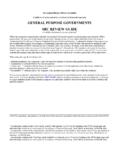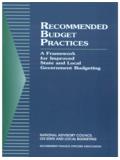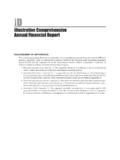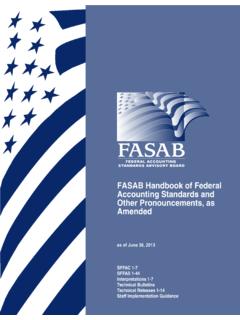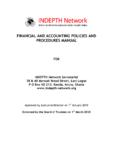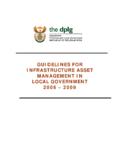Transcription of The New Blue Book - Government Finance Officers Association
1 The New blue BookBy STEPHEN J. GAUTHIERA ugust 2012 | Government Finance Review 29 This spring, the Government Finance Officers Association (GFOA) released a new edition of its classic blue book , Governmental Accounting, Auditing, and Financial Reporting (GAAFR). The first blue book was published some 75 ago, in 1936. Subsequent editions appeared in 1951, 1968, 1980, 1988, 1994, 2001, and 2005, making this this latest ver-sion the ninth edition. This newest GAAFR has been com-pletely rewritten and significantly expanded, with compre-hensive coverage through GASB Statement No. 66, Technical Corrections S CHANGED SINCE 2005?The last edition of the GAAFR was released in 2005. Since then, a number of significant developments have taken place that significantly affect accounting, auditing, and financial reporting for state and local governments:n The Governmental Accounting Standards Board (GASB) issued 21 statements, two technical bulletins, and three concepts statements.
2 Meanwhile, the GASB s staff con-tinued to offer extensive guidance on a broad range of technical issues by means of annual updates to the GASB s Comprehensive Implementation The Government Accountability Office (GAO) revised Government Auditing Standards (commonly known as the Yellow book ). n The Committee of Sponsoring Organizations (COSO) of the Treadway Commission issued detailed guidance on the monitoring component of its comprehensive frame-work of internal The GFOA issued or updated 19 best practices or adviso-ries that directly relate to governmental accounting, audit-ing, and financial a result of these developments, among other things:n A completely new approach is now in effect for clas-sifying the components of fund balance in governmental Important limitations have been placed on the use of the special revenue fund The rules for identifying component units and incorporat-ing their data into the report of the financial reporting entity have been substantially Governments must now distinguish assets from deferred outflows of resources and liabilities from deferred inflows of addition, the GASB has provided a wealth of detailed guidance on a variety of specialized topics, including termi-nation benefits, pollution remediation obligations, intangible assets (including computer software), derivatives, and service concession arrangements (that is, public/private and public/public partnerships, or PPPs).
3 WHAT S NEW ABOUT THE book ITSELF?All the recent editions of the GAAFR have used a 8 x 11 format to accommodate the reproduction of a complete illustra-tive comprehensive annual financial report (CAFR). The illustrative CAFR that accompanies this new edition of the blue book has been made avail-able online, which allowed the new version to be printed in a more com-pact and convenient 7 x 10 editions of the blue book were also accompanied by a separate study guide that offered outlines and exercises. The new GAAFR offers a chapter in brief summary and exer-cises (with correct responses) for each chapter, obviating the need for a separate study the past, individual chapters of the GAAFR were often broad in scope. For example, the 2005 edition of the blue book devoted a single chapter to all four sets of basic finan-cial statements.
4 Conversely, the new edition of the GAAFR aims to facilitate easy access to specific topics through the use of shorter, more narrowly focused chapters. Thus, the new blue book replaces the single chapter previously devoted to Financial Reporting with separate individual chapters on Governmental Fund Financial Statements, Proprietary Fund Financial Statements, Fiduciary Fund Financial Statements, and Government -wide Financial Statements. In the same way, the single chapter on Governmental Funds in the previ-The last edition of the GAAFR was released in 2005. Since then, a number of significant developments have taken place that significantly affect accounting, auditing, and financial reporting for state and local governments. 30 Government Finance Review | August 2012ous edition has been replaced by sepa-rate chapters on Revenue Recognition in Governmental Funds, Expenditure Recognition in Governmental Funds, Other Financing Sources and Uses, and Asset and Liability Recognition and Measurement in Governmental Funds.
5 Also in the past, aspects of a single technical topic were often addressed in different chapters. Thus, for exam-ple, a reader who wanted to gain a comprehensive understanding of the appropriate accounting and financial reporting for an advance refunding needed to consult both the chapter on Governmental Funds and the chapter on Proprietary Funds. In contrast, the new GAAFR has been expanded to include chapters that offer a com-prehensive treatment of a wide range of specialized topics (for example, Capital Assets, Debt, Derivatives, Risk Financing and Insurance ).The combined effect of the changes just described explains how the number of chapters in the new GAAFR has more than doubled, from 19 to S IN THE NEW GAAFR?The text of the new GAAFR is divided into five parts: 1) Background and Framework; 2) Fund Accounting and the Basic Financial Statements; 3) Specialized Accounting Applications; 4) Reporting Beyond the Basic Financial Statements; and 5) Internal Control, Auditing, and 1: Background and Framework.
6 The first part of the new GAAFR is subdivided into three subsections that address basic background, the governmental financial reporting model, and basic recognition A: Basic Background. The first three chapters of the new blue book provide a basic foundation for approaching governmental accounting and financial 1, Accounting, Financial Reporting, and the Financial Statement Audit: an Overview, explains how accounting, auditing, and financial reporting relate to each other, taking special care to distinguish accounting from financial reporting. It then goes on to examine the different types of financial reporting (internal financial reporting, special-purpose external financial reporting, general purpose external financial reporting), the different means of communicat-ing financial information in general-purpose external financial reports (display, disclosure, supporting infor-mation), the basic financial statement elements (assets, liabilities, deferred inflows of resources, deferred out-flows of resources, inflows of resourc-es, outflows of resources, and net position), and the essential characteristics of accounting data.
7 Chapter 2, The Government Environment and Its Impact on Accounting and Financial Reporting, describes the spe-cial environment in which state and local governments oper-ate (service motive versus profit motive, focus on stewardship versus focus on return on investment, budgets that have the force of law versus budgets that function solely as financial plans for management) and explains how that environment led to certain unique features of accounting and financial reporting for state and local governments (the use of more than one measurement focus and basis of accounting, the use of fund accounting, the inclusion of budgetary compari-sons as part of financial reporting).Chapter 3, Sources of Governmental GAAP, examines the nature and purpose of generally accepted accounting prin-ciples (GAAP), the legal authority for setting GAAP for state and local governments, the historical development of GAAP, and the structure and procedures used to set new standards.
8 It also describes the GAAP hierarchy as it applies to state and local B: The Governmental Financial Reporting Model. The next three chapters of the new blue book introduce the gov-ernmental financial reporting model, with its unique combi-nation of fund accounting and Government -wide 4, Funds, Fund Types and Interfund Activity, describes the nature and purpose of fund accounting, the number of funds principle, how funds are classified into fund types and fund categories, and the proper use of each fund type. It also explores the different types of interfund activity (loans, interfund services provided and used, trans-fers, reimbursements). This newest GAAFR has been com-pletely rewritten and significantly expanded, with comprehensive coverage through GASB Statement No. 66, Technical Corrections 2012 | Government Finance Review 31 Chapter 5, Government -wide Financial Reporting explains how fund data are incorporated into the two activities col-umns reported in the Government -wide financial statements, a process that requires converting fund data to a single measurement focus and basis of accounting (conversion), eliminating duplications (consolidation), and ensuring that functional costs report all associated direct costs and only direct 6, The Primary Government and Its Component Units, explains how financial reports for state and local governments combine the primary Government , as legally defined, with certain other legally separate component units.
9 It also explains how data from individual component units are incorporated into the financial statements of the combined financial reporting entity. The discussion incor-porates the important recent changes that resulted from the issuance of GASB Statement No. 61, The Financial Reporting Entity: Omnibus, an amendment of GASB Statements No. 14 and No. C: Basic recognition principles. The following two chapters consider what is measured (measurement focus) and when it is measured (basis of accounting). They also explain how transactions are classified and how their clas-sification affects when they are 7, Measurement Focus and Basis of Accounting, compares and contrasts the economic resources measure-ment focus and the accrual basis of accounting with the current financial resources measurement focus and the modi-fied accrual basis of 8, Categories of Transactions and Events and Their Recognition, distinguishes exchange transactions and exchange-like transactions from various types of non-exchange transactions (derived tax revenues, imposed nonexchange revenues, Government -mandated nonexchange transactions, and voluntary nonexchange transactions).
10 It also distinguishes extraordinary items from special itemsand clarifies when direct adjustments to net position are appropriate. Part 2: Fund Accounting and the Basic Financial Statements. The second part of the new GAAFR, which is devoted to fund accounting and the basic financial state-ments, is subdivided into subsections that address govern-mental funds, proprietary funds, fiduciary funds, Government -wide financial statements, and A: Governmental Funds. There follow five chapters devoted to the various aspects of accounting and financial reporting for governmental 9, Revenue Recognition in Governmental Funds, examines how the current financial resources measurement focus and the modified accrual basis of accounting affect the recognition of the various types of revenues commonly accounted for in governmental funds.

